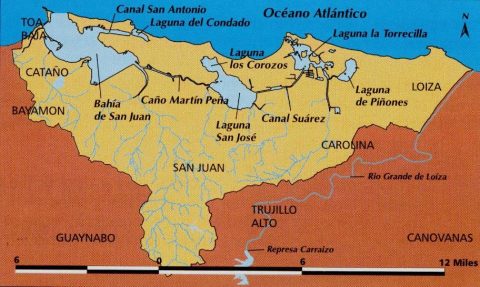INTRODUCTION
The San Juan Bay Estuary Program, hereinafter called “Estuario”, requests proposals from qualified firms to perform an assessment of contaminants in sediments and fish tissue in the San Juan Bay Estuary.
A scope of work (Deliverable Components – Section V) is included to assist interested firms, hereinafter called “the Contractor”, in the preparation of a proposal for performing the implementation of the study. The Contractor should not be limited by this general scope of work but must address all of the solutions and work products called for in this Request for Proposal (RFP). Failure to submit information in accordance with the requirements and procedures established in this document may cause for disqualification. A Mandatory Informative Meeting will take place in order to broaden the potential Contractor’s understanding of the Estuario’s objectives, background and needs.
PROGRAM OVERVIEW
Section 320 of the U.S. Clean Water Act created the National Estuary Program (NEP). According to the law’s model, it allows the governors of coastal states with estuaries to submit these bodies of water to the Administrator of the U.S. Environmental Protection Agency. The objective is that they reach the category of national importance, and can receive federal funds directed to research, draft and coordinate the implementation of a comprehensive plan for estuarine management and conservation. On April 20, 1993, the Governor of Puerto Rico signed the official designation of the San Juan Bay Estuary system as one of national importance to the United States. Then, in 1994, the San Juan Bay Estuary Program was launched. The San Juan Bay Estuary is the only tropical estuary system within the NEP outside the continental United States. The Estuario operates as a nonprofit organization that works to protect this ecosystem and its watershed. The watershed extends throughout the San Juan metropolitan region and its eight municipalities, Bayamón, Carolina, Cataño, Guaynabo, Loíza, San Juan, Toa Baja and Trujillo Alto. The Estuario coordinates and ensures the implementation of restoration, enhancement and conservation actions established in the Compressive Conservation and Management and Plan.
PROJECT DESCRIPTION
The San Juan Bay Estuary Program has developed a long-term environmental indicator study in order to help ascertain the effectiveness of implemented restoration efforts. One of its components is the assessment of sediments texture, total organic carbon, trace metals, and organic pollutants in sediments of selected water bodies of the San Juan Bay Estuary system. Furthermore, analysis of fish and crab tissue were performed for priority pollutants metals, PCBs, PAHs, and total organic-chlorine pesticides including DDT and dieldrin in selected water bodies of the San Juan Bay Estuary. The findings were presented in study title “Estuarine Environmental Indicators for the San Juan Bay Estuary: Assessment of Sediment and Fish Tissue Contaminants” that was published in September 28, 2011. The new phase of the aforementioned study is now scheduled to be repeated in fiscal year 2021.
Contaminants of emergent concern (CECs) may include medicines, personal care or household cleaning products, lawn care, and agricultural products, among others. These chemicals make it into water bodies and have a detrimental effect on fish and other aquatic species and have also been shown to bioaccumulate up the food web – putting even non-aquatic species – including humans – at risk when they eat contaminated fish.
CECs, including pharmaceuticals and PCPs, are increasingly being detected at low levels in surface water in the USA, and there is concern that these compounds may have an impact on aquatic life. It is important for Estuario to have an approach for determining protective levels for aquatic organisms due to the potential impact on aquatic life. This will be the first effort to characterize and provide baseline data regarding CECs in the SJBE system.
PROJECT LOCATION
The project location is the watershed or drainage basin of the San Juan Bay Estuary which extends above a broad, flat coastal plain and consists of 83 square miles (215 km2) of land and 14 square miles (36 km2) of water. The San Juan Bay Estuary ecosystem is comprised by the San Juan Bay and a number of smaller channels and lagoons. Some of these bodies of water include the San Antonio Canal, Condado Lagoon, San José Lagoon, Los Corozos Lagoon, Suárez Canal, Torrecilla Lagoon, and the Piñones Lagoon as well as the interconnecting Martín Peña and San Antonio Channels and the Suárez Canal (See Figure 1). Fresh water flows into the system from the creeks and rivers in the watershed, including the Puerto Nuevo River, Juan Méndez Creek, San Antón Creek, Blasina Creek, and the Malaria Canal. During extreme flood events, fresh water is also received from the Río Grande de Loíza. Ocean water enters the system through three openings: Boca del Morro, El Boquerón at the Condado Lagoon, and Boca de Cangrejos.
The SJBE system is also defined by small isolated creeks and canals as well as upland areas that drain into the estuary waters described above. The watershed or drainage basin is relatively small (< 97 square miles (251 km2). It extends above a broad, flat coastal plain and consists of 83 square miles (215 km2) of land and 14 square miles (36 km2) of water. Parts of eight municipalities join to form the estuary’s watershed: Toa Baja, Cataño, Bayamón, San Juan, Guaynabo, Carolina, Loíza, and Trujillo Alto. Land uses and activities in these areas are closely linked to water quality impacts and the degradation of habitat in the estuary.

PROJECT SCOPE OF WORK
The Contractor will be selected based on responses to this RFP through assistance to the Mandatory Informative Meeting and the proposal document. The Contractor will serve as a resource on scientific/technical issues and assist in the tasks described below (within the estimated timeframes). The SJBE Program’s Staff, the Scientific and Technical Advisory Committee (STAC) will be involved in the project but, as described in the requested services, the Contractor will have lead responsibility for the detailed functions.
This action is designed to complete an assessment regarding pollutants in sediments and fish and shellfish tissues in the San Juan Bay Estuary.
The main goal is to replicate the study performed in 2011 title “Estuarine Environmental Indicators for the San Juan Bay Estuary: Assessment of Sediment and Fish Tissue Contaminants”, compare both data set, and perform an assessment of emergent contaminants.
The specific objectives are:
- Quantify sediments texture, total organic carbon, trace metals, organic, emergent, and priority pollutants in sediments on preselected stations in the San Juan Bay Estuary system.
- Analyze fish and crab tissue for priority pollutants, metals, total polychlorinated biphenyls (PCBs), total polycyclic aromatic hydrocarbons (PAHs), pollutants, contaminants of emerging concern (CECs), and total organic-chlorine pesticides including DDT, and dieldrin collected on preselected stations in the San Juan Bay Estuary.
REQUESTED SERVICES
The Contractor will:
- Develop a Quality Assurance Project Plan (QAPP) approved by EPA before sampling activities
- Provide a report with findings, analysis, and recommendations regarding pollutants in sediments and fish and shellfish tissues in the San Juan Bay Estuary
- Develop a PowerPoint presentation and educational brochure about findings and recommendations in an easy-to-understand language
- Results will be integrated into Estuario’s web atlas
PROPOSAL REQUIREMENTS
The Project Proposal is required to address the following items in a concise and yet
complete manner and offer all the necessary information for the evaluation of your proposal:
- Project objectives and goals.
- Proposed detailed methodology.
- Identification of all tasks to be completed by subcontractors and a detailed budget.
- A listing of any special skills, innovative concepts for projects and/or any cost control methods proposed for this project.
- If more than one individual will be involved, a description of the organization of your project team, including information of the individuals that will perform each function and their level of experience and education should be provided. The person who will be responsible for the completion of the project need to be clearly identified.
- The dates you will be able to start and finish your project, as well as a detailed time frame regarding reports, milestones and/or specific activities.
- Other issues or information relevant to your proposal.
- Copy of the Department of State certification to do business in Puerto Rico.
- A certification of compliance with all federal and state laws to conduct business in Puerto Rico shall be included in your proposal.
OTHER GENERAL REQUIREMENTS FOR SUBMITTING
PROPOSALS TO THE PROGRAM
- Proposals shall include a Statement of Qualifications; Experience of the potential Contractor in similar work, facilities, senior personnel qualifications, number and qualification of junior personnel.
- Budget for materials, expenses and other items must be detailed.
- Projects must include a reporting plan and final document. Other documents such as brochures, graphs, posters or visual materials are encouraged.
- Proposals will be evaluated by an advisory committee who will make the final decision.
PRE-SUBMISSION ACTIVITIES
- Informative Meeting
An informative video conference/meeting will be held on February 5, 2021 at 10:00 a.m. This is a mandatory meeting for a Proposal to be accepted. It will be the only opportunity to directly discuss and clarify with the Program’s staff any questions potential Contractors may have regarding the RFP.
- Questions Concerning Request for Proposals
All questions prior to the Informative Meeting should be held until the meeting takes place so that all potential Contractors may benefit from a question and answer discussion.
- Revision to the Request for Proposals
The Program reserves the right, at its sole discretion, to:
- Cancel this RFP at any time.
- Revise the RFP prior to the date that Proposals are due. Revisions to the
RFP shall be emailed to all potential Contractors to whom the RFP was originally distributed to and those who notified the Program in writing of their interest in submitting a Proposal.
- Extend the date by which the Proposals are due.
SUBMISSION REQUIREMENTS
For a proposal to be considered for evaluation, potential Contractors must follow the specifications below:
- Send the proposal by email to: [email protected] and [email protected]
- Potential Contractors must submit their proposal no later than 12:00 a.m. on February 26 2021. Late proposals, proposals delivered by mail or other means, or proposals from entities that did not attend the Mandatory Informative Meeting will not be accepted. No exceptions will be granted regardless of reason or circumstance.
- Failure to comply with the requirements of this RFP may result in disqualification.
EVALUATION CRITERIA
Qualified potential Contractors will be short-listed and the final selection will be made by an advisory committee. The criteria that will be used to evaluate the Proposals will be:
- Comprehensiveness of the proposal.
- The individual or firm’s experience and history of performance on similar projects, regarding such factors as quality of work, cost control, and ability to meet schedule.
- Adequacy of technical staff, as demonstrated by experience, education, and potential project role.
- The firm or individual’s understanding of the services required by the Program.
- Proposed costs.
- The organization and scheduling of the project requirements.
- Knowledge and ability to comply with federal procurement standards and grant regulations.
- The professional quality of the Project Proposal: conciseness, clarity, and thoroughness of presentation.
- Project Manager accessibility.
- Ability to complete project in a short period of time.
CALENDAR OF EVENTS
The Program anticipates that the process for nominating and selecting a vendor, and awarding the contract, will be according to the following tentative schedule:
RFP Release: January 25, 2021
Informative, Final Scope and Deliverable Meeting: February 5, 2021 at 10:00 AM. PLEASE CONFIRM YOUR PARTICIPATION BY EMAIL TO [email protected].
Proposal Due Date: February 26, 2021
Award Notification: March 5, 2021
IMPORTANT: The Contractor should be able to complete all the Deliverable Components (Section IV) for August 30, 2021
SPECIAL CONDITIONS
- Reservations
This RFP does not commit the Estuario to award a contract, to defray any costs incurred in the preparation of a Proposal pursuant to this RFP, or to procure or contract for work.
- Public Records
All Proposals submitted in response to this RFP become the property of the Program and public records, and as such may be subject to public review.
- Right to Cancel
The Estuario, at its sole discretion, reserves the right to cancel this RFP for any or no reason, in part or in its entirety, including but not limited to: selection schedule, submittal date, and submittal requirements. If the Estuario cancels or revises the RFP, all potential Contractors will be notified in writing by the Estuario.
- Additional Information
The Estuario reserves the right to request additional information and/or clarifications from any or all potential Contractors to this RFP.
- Public Information
Selection announcements, contract awards, and all data provided by the Program shall be protected from public disclosure. Consultants desiring to release information to the public must receive prior written approval from the Estuario. The Estuario, at its sole discretion, shall determine the release and disclosure of information related to this RFP and any final work products as a result of this.
The San Juan Bay Estuary Program (SJBEP) is part of the National Estuary Program (NEP), created under Section 320 of the Clean Water Act (CWA), and managed nationally by the United States Environmental Protection Agency (USEPA). Its mission is to improve the water quality of the San Juan Bay Estuary. Per Section 320 of the CWA, each of the 28 entities affiliated to the NEP must submit to EPA Administrator a Comprehensive Conservation and Management Plan (CCMP) to guide the restoration efforts of the most important coastal ecosystems for the economy of the Nation. The main responsibility of each organization under the NEP is to coordinate and measure the implementation of the plan in partnership with the community, state, local, and federal governments and the Academia.
The Corporation for the Conservation of the SJBE provides equal employment opportunities (EEO) to all employees and applicants for employment without regard to race, color, religion, sex, sexual orientation, gender identity, national origin, age, disability or genetics.


